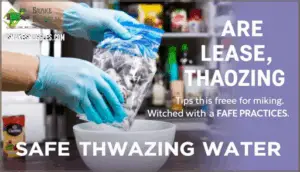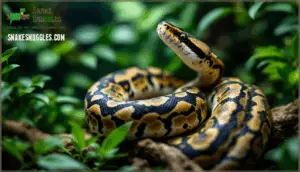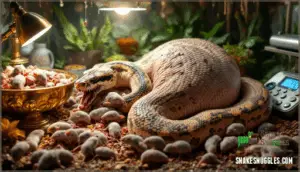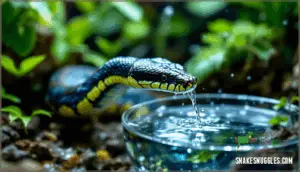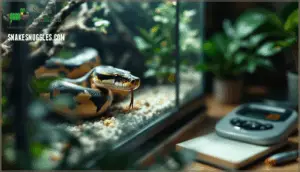This site is supported by our readers. We may earn a commission, at no cost to you, if you purchase through links.
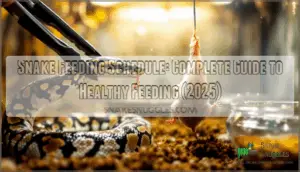 A ball python refusing a meal for three weeks straight isn’t just being picky—it’s often trying to tell you something about your feeding schedule. Most new snake owners either panic-feed their pets weekly regardless of age, or accidentally starve a growing juvenile by treating it like an adult.
A ball python refusing a meal for three weeks straight isn’t just being picky—it’s often trying to tell you something about your feeding schedule. Most new snake owners either panic-feed their pets weekly regardless of age, or accidentally starve a growing juvenile by treating it like an adult.
The difference between these approaches can mean the gap between a thriving snake and one battling obesity or stunted growth. Getting your feeding schedule right requires understanding your specific snake’s species, age, and activity level, then matching prey size and frequency to its actual metabolic needs.
Master this balance, and you’ll avoid the two most common reptile keeper mistakes: overfeeding adult snakes into health problems, or underfeeding young ones during their critical growth window.
Table Of Contents
- Key Takeaways
- Choosing The Right Snake Food
- Best Snake Feeding Schedule
- Preparing Food for Your Pet Snake
- Snake Feeding Habits and Behaviors
- Recognizing Hunger and Fullness Cues
- Adjusting Feeding Based on Behavior
- Understanding Your Snake’s Prey Preference
- Monitoring Snake Health and Adjusting Feeding
- Snake Age and Feeding Frequency
- Snake Size and Feeding Frequency
- Snake Activity Level and Feeding Frequency
- Environmental Factors and Feeding Frequency
- The Dangers of Overfeeding Your Snake
- Snake Feeding Mistakes to Avoid
- Supplements and Vitamins for Your Pet Snake
- Providing Fresh Water for Your Snake
- Monitoring and Adjusting Your Snake’s Feeding Schedule
- Frequently Asked Questions (FAQs)
- How often should a pet snake be fed?
- How do you feed a snake a healthy diet?
- How many times a week should a northern watersnake eat?
- How often should you feed a corn snake?
- How much prey should a snake eat?
- Why is feeding frequency important in snake care?
- How often should I feed snakes?
- Should I feed my snake at night or day?
- What is the best feeding schedule for ball pythons?
- Can you feed a snake every 3 days?
- Conclusion
Key Takeaways
- Feed juvenile snakes every 5–7 days to support rapid growth, while adult snakes thrive on 10–14 day intervals—matching feeding frequency to age and metabolism prevents both obesity from overfeeding and stunted development from underfeeding.
- Prey size should match roughly 10% of your snake’s body weight and be no wider than 1.5 times its thickest point, since properly sized meals prevent regurgitation, metabolic stress, and choking hazards while delivering complete nutrition.
- Frozen-thawed prey eliminates bite wounds and parasite risks compared to live feeding, maintains strong nutritional value when properly stored, and most snakes adapt quickly to frozen options with correct thawing and presentation techniques.
- Your snake’s behavior reveals its actual feeding needs—increased tongue-flicking and exploration signal hunger, while meal refusals often indicate shedding cycles, breeding status, or satiety rather than illness, so adjust schedules based on these cues instead of rigid calendars.
Choosing The Right Snake Food
Picking the right food for your snake isn’t just about grabbing whatever’s available—it’s about matching prey size, type, and quality to your snake’s specific needs. Different species have different dietary requirements, and the way you present that meal matters more than you might think.
Let’s break down what you need to know to keep your snake healthy and well-fed.
Importance of Prey Size and Quality
Getting the prey size right is like Goldilocks hunting for porridge—too big, and your snake’s in trouble; too small, and they’re left hungry. Aim for prey slightly wider than your snake’s thickest point and roughly 10% of its body weight. Here’s what matters most:
- Nutritional value: Whole prey delivers complete nutrition—bones, organs, and all
- Digestibility factors: Properly sized meals prevent regurgitation and metabolic stress
- Growth impact: Quality prey aids healthy development without forcing rapid weight gain
- Prey sourcing: Fresh or frozen-thawed options beat questionable live sources
- Ethical considerations: Humanely raised feeders reflect responsible snake size management
Poor prey quality compromises nutrient density, leaving your snake malnourished despite regular feeding.
Prey Types for Different Snake Species
Once you’ve nailed prey size, matching prey types to your snake species becomes straightforward. Ball pythons thrive on rats for higher protein content, while corn snakes do well with mice—both representing essential rodent variety. Larger constrictors like Burmese pythons readily accept avian prey such as chickens or quail. Aquatic diets suit water snakes that naturally hunt fish and amphibians, though ophiophagy risks exist when kingsnakes target venomous species. Some smaller colubrids rely on invertebrate options like insects. Understanding your snake species guarantees proper nutritional coverage. A varied diet, including options like chicks or quail, can offer dietary enrichment for boa constrictors.
- Mice and rats: Perfect rodents for most colubrids and pythons
- Birds/poultry: Natural prey types for large constrictors
- Fish and amphibians: Essential for semi-aquatic specialists
- Other snakes: Consumed by ophiophagous species like kingsnakes
- Invertebrates: Critical for juvenile and small-bodied snakes
Feeding Live Vs. Frozen Prey
Once you’ve matched the right prey type to your species, you’ll need to decide whether to offer it live or frozen—a choice that directly affects your snake’s safety and your peace of mind.
Live prey risks bite wounds and stress during feeding, whereas frozen prey eliminates those dangers entirely. Frozen nutrition loss is minimal when properly stored, and ethical considerations favor humane pre-killed options.
While some snakes show prey preference shifts initially, most adapt quickly to frozen-thawed prey with proper presentation techniques, making it the safer, more cost-effective choice for responsible keepers.
Benefits of Frozen-Thawed Prey
Switching to frozen-thawed prey isn’t just about safety—it’s a smart move that makes your life easier and keeps your snake healthier in ways you might not expect. You’ll eliminate parasite reduction risks, enjoy storage convenience with months-long freezer life, and sidestep ethical considerations around live feeding. Nutrient retention stays strong when you’re thawing frozen prey safely, and prey availability expands since you’re not limited to what’s alive at your local shop.
Here’s what frozen-thawed prey delivers:
- Zero bite wounds – Your snake won’t face scratches or stress from struggling rodents
- Stockpile freedom – Buy in bulk and store what you need without weekly pet store runs
- Consistent nutrition – Properly prepared frozen prey maintains the vitamins and minerals your snake needs
When comparing live vs frozen-thawed prey, the benefits of frozen-thawed prey win on nearly every front, from preparing frozen-thawed prey to long-term health outcomes.
Best Snake Feeding Schedule
Getting your snake’s feeding schedule right isn’t guesswork—it’s about understanding what drives their appetite. Age, size, activity level, and even whether your snake is breeding all play into how often you should offer food.
Here’s what you need to know to dial in the perfect feeding rhythm for your pet.
Factors Affecting Snake Feeding Frequency
Your snake’s feeding schedule isn’t one-size-fits-all. Species differences matter greatly—garter snakes have roughly twice the metabolic rate of boas at equal length, so they need more frequent meals. Snake size and feeding frequency go hand in hand: smaller snakes eat every 5–7 days, while larger pythons can wait 14–28 days between meals.
Temperature influence is powerful too; warmer conditions can slash digestion time by up to 50%, letting your snake process meals faster. Reproductive status plays a role as well—gravid females may reduce feeding by 80% during pregnancy. Snake activity level and feeding frequency connect directly; active snakes consume prey up to 40% more often than sedentary ones.
Feeding Frequency for Young Snakes
Young snakes grow like weeds on fast-forward, so you’ll need to feed them more often than their adult counterparts. Here’s your game plan for keeping juveniles well-fed:
- Feed every 5–7 days during peak growth phases to match their metabolic demands.
- Choose prey 10–15% of body weight—meal size affects digestion and development.
- Adjust during shedding cycles since food refusal before a shed is normal.
- Account for species variation—corn snake hatchlings eat more frequently than ball python juveniles.
Monitor your young snake’s body condition weekly to dial in the perfect feeding schedule.
Feeding Frequency for Adult Snakes
Once your snake hits adulthood, feeding shifts from a sprint to a comfortable marathon—think every 10 to 14 days instead of the weekly routine juveniles demand. Adult snake metabolism slows down, and prey digestion time increases considerably. Adjust your feeding schedule based on snake size and individual variation—larger pythons might stretch to three weeks between meals.
| Snake Species | Typical Adult Feeding Interval |
|---|---|
| Ball Python | 10–14 days |
| Corn Snake | 7–10 days |
| Boa Constrictor | 14–21 days |
| King Snake | 7–10 days |
| Reticulated Python | 14–28 days |
Watch for shedding and feeding patterns—your snake won’t eat during a shed cycle, and that’s perfectly normal. During brumation effects in winter months, some species naturally reduce appetite. Monitor snake health by tracking body condition rather than sticking rigidly to calendars.
Feeding Frequency for Pregnant or Breeding Snakes
Breeding season turns your snake into a nutrient-burning furnace, and feeding schedules need to match that metabolic shift. Pregnant females need prey every 5–7 days during gestation feeding and egg production, with calcium-rich options prioritized.
After laying, postpartum feeding resumes cautiously—wait 7–10 days before offering smaller meals. Breeding recovery demands patience; don’t rush back to normal snake feeding schedules until her body condition stabilizes and breeding snakes regain strength.
Preparing Food for Your Pet Snake
Getting your snake’s food ready isn’t just about thawing and tossing—there’s a method to it. Proper preparation keeps your snake safe and makes certain they get the most from every meal.
Let’s walk through the key steps to make feeding time smooth and nutritious.
Thawing Frozen Prey Safely
If you’ve ever pulled a frozen dinner out of the freezer, you already know that thawing something the wrong way can turn dinner into a disaster—and the same rule applies to your snake’s meal. The safest thawing methods are refrigerator thawing overnight or submerging sealed prey in warm (not hot) water for quicker results.
Safe thawing temps stay below 70°F to prevent bacterial contamination, while thawing timeframes vary by prey size—usually 12-24 hours in the fridge or 30-60 minutes in water. Never microwave or leave prey at room temperature, and avoid refreezing risks by feeding once thawed.
Feeding Prey Whole for Healthy Digestion
Your snake’s digestive system evolved to process whole prey—bones, organs, and all—which means cutting corners with partial meals can shortchange their nutritional needs and even increase health risks. Here’s why whole prey matters:
- Bone Digestion provides calcium your snake can’t get from muscle tissue alone
- Nutrient Absorption works best when digestive systems process complete prey items
- Natural Instincts kick in with whole prey, reducing stress during feeding
- Choking Hazards actually decrease when prey size matches your snake’s girth properly
This approach delivers prime snake nutrition while respecting how these animals feed in nature.
Prey Presentation and Feeding Techniques
The way you serve up frozen-thawed prey can mean the difference between a snake that strikes with confidence and one that turns up its nose—so let’s talk smart presentation. Your feeding techniques create the right feeding environment for natural snake feeding habits:
- Warm the prey in a sealed bag submerged in warm water—body temperature triggers feeding responses
- Use feeding tongs to mimic live movement and protect your hands
- Try scent coating with chicken broth if your snake’s hesitant
- Feed during best times—evening hours when your snake’s naturally active
A separate tub can minimize stress and keep bedding out of meals.
Gut Loading Prey for Nutritional Value
What you feed your prey animals in the days before offering them to your snake directly impacts the nutrients your pet receives—a practice herpetologists call gut-loading. By providing nutrient-rich diets to mice, rats, or other prey species 24-48 hours before feeding time, you’re basically creating living vitamin capsules.
Feed rodents dark leafy greens, quality pellets, and calcium-dusted vegetables to boost nutritional content. This gut-loading method works beautifully with whole prey feeding—your snake gets enhanced nutritional value without injections or force-feeding.
Think of it as supplement synergy: the prey animals do the work while your snake reaps the benefits through natural feeding behaviors, supporting enhanced snake health from the inside out.
Snake Feeding Habits and Behaviors
Your snake’s behavior tells you everything you need to know about its feeding needs. Learning to read these signals helps you maintain the right schedule and prevent common feeding mistakes.
Let’s break down the key behaviors and factors that shape how often your snake should eat.
Recognizing Hunger and Fullness Cues
Learning to read your snake’s signals separates guesswork from confident care. Watch for these hunger cues and fullness cues that reveal feeding readiness:
- Increased tongue flicking during foraging activity signals active prey detection
- Heightened movement around the enclosure shows hunger-driven searching behavior
- Post-meal behavior shifts to stillness and reduced visibility for 5–7 days
- Hunger strikes lasting months may indicate fullness, breeding cycles, or anorexia causes requiring attention
Recognizing these snake feeding habits and behaviors keeps your feeding schedule aligned with natural feeding signals.
Adjusting Feeding Based on Behavior
Once you’ve decoded those hunger signals, the next step is tweaking your feeding routine to match what your snake’s actually telling you. If increased activity level and persistent tongue-flicking scream hunger, consider shortening intervals. If your snake refuses meals, check for shedding cycles, breeding behavior, or stress signs—common refusal reasons. Regurgitation causes often trace back to overfeeding or disturbing it too soon, so dial back portion size or wait longer between feedings.
| Behavior Observed | What It Means | Feeding Adjustment |
|---|---|---|
| Increased exploration, tongue-flicking | Strong hunger cues | Shorten feeding interval by 1–2 days |
| Refusing meals, hiding | Fullness cues, stress signs, or shedding cycles | Skip next feeding; reassess in 5–7 days |
| Regurgitation after feeding | Overfeeding or stress | Reduce prey size by 20%; wait 10–14 days before next meal |
Adjusting feeding based on behavior keeps your snake healthy and your feeding signals sharp.
Understanding Your Snake’s Prey Preference
Every snake has its own menu preferences, and figuring out what your particular reptile craves—whether it’s mice, rats, chicks, or even fish—can mean the difference between enthusiastic strikes and frustrating meal refusals.
Observe hunting behavior closely: Does your snake species strike faster at dark-furred prey or pale ones? Prey types matter, too—some snakes prefer the scent profile of frozen freshness over live offerings.
Understanding snake diet means matching prey size to nutritional needs while respecting individual quirks. Choosing the right prey transforms feeding from guesswork into success.
Monitoring Snake Health and Adjusting Feeding
Watching your snake’s body condition, behavior, and waste output is like reading a living report card—one that tells you exactly when to dial feeding up, down, or keep cruising steady. Weight monitoring every two weeks reveals whether you’re hitting the mark or missing it entirely.
Watch for appetite changes, weight fluctuations, and regurgitation causes like oversized prey or premature handling. Obesity prevention starts with adjusting feeding frequency when your snake’s midsection thickens beyond healthy proportions.
Hydration levels and supplement needs become apparent through skin elasticity and shed quality—health issues signal it’s time to recalibrate your approach immediately.
Snake Age and Feeding Frequency
Age isn’t just a number when you’re feeding a snake—it’s practically the dial that controls how often the food bowl gets filled. Matching snake feeding schedules to life stage isn’t optional—it’s how you keep young snakes thriving and adult snakes fit without tipping into obesity territory.
Hatchling diets kick off the journey: tiny neonates need meals every 5-7 days because their growth rates are off the charts. Juvenile feeding continues this aggressive schedule through their first year, fueling rapid body development.
Once your snake hits adulthood, the pace slows dramatically—adult schedules commonly shift to every 10-14 days as metabolic demands drop. Senior snakes may stretch even longer between meals, sometimes hitting 14-21 days.
Snake Size and Feeding Frequency
Size doesn’t just determine how much your snake eats—it’s the master dial for how often meals arrive. Smaller specimens burn through calories faster, demanding more frequent feeding schedules, while larger adult snakes coast on slower metabolisms. Here’s your roadmap:
- Hatchlings (under 12 inches): Feed every 5-7 days—juvenile feeding fosters growth.
- Sub-adults (12-36 inches): Shift to 7-10-day intervals as metabolism adjusts.
- Adult snakes (over 36 inches): Adult portions arrive every 10-14 days, preventing obesity risks.
- Giants (5+ feet): Best schedules stretch to 14-21 days—prey size matters more than frequency here.
Match young snakes to tighter feeding frequency; your ball python’s girth tells you when to throttle back.
Snake Activity Level and Feeding Frequency
Your snake’s activity level is like a fuel gauge—active hunters burn through calories faster than sedentary species, and ignoring this difference can throw your entire feeding schedule off track. A restless corn snake prowling its enclosure burns more energy than a ball python coiled under its hide, demanding tighter feeding intervals.
Metabolic rates spike during basking behavior and drop during shedding cycles. Monitor your snake’s movement patterns and adjust accordingly—active specimens need meals every 7-10 days, while low-energy snakes thrive on 10-14-day schedules.
Environmental Factors and Feeding Frequency
Temperature isn’t just background noise—it’s the invisible hand controlling your snake’s appetite, digestion speed, and even willingness to strike at prey. Warmer habitat conditions accelerate metabolism, meaning you’ll feed more frequently, while seasonal changes slow everything down. Environmental conditions like humidity levels and molting impact also shift feeding frequency—stressed snakes won’t eat.
- Temperature effects: Basking zones above 85°F boost activity level and digestion
- Humidity levels: Proper moisture (50-70%) reduces snake stress during feeding
- Seasonal changes: Winter dormancy naturally decreases appetite
The Dangers of Overfeeding Your Snake
It’s easy to think more food equals a healthier snake, but overfeeding can actually harm your pet in ways that aren’t always obvious at first. From obesity to organ strain, feeding too much or too often creates real health risks that every snake owner should understand.
Let’s break down what happens when snakes get too much of a good thing and how you can keep your pet on track.
Risks of Obesity in Snakes
Overfeeding sets off a cascade of metabolic effects that can silently wreck your snake’s health. Obesity in snakes isn’t just cosmetic—it triggers serious health complications like fatty liver disease, cardiovascular strain, and respiratory distress. You’ll notice reduced mobility as excess weight burdens joints and muscles, making even basic movement exhausting. These health issues compound over time, shortening lifespan considerably.
Weight management requires discipline: stick to species-appropriate feeding schedules and resist the urge to overfeed. Exercise importance can’t be overstated—provide climbing branches and adequate space for movement. Dietary adjustments, like slightly smaller prey or extended feeding intervals, help reverse obesity symptoms before permanent damage occurs.
Signs and Symptoms of Overfeeding
If you’ve ever watched your snake turn down a meal or struggle to coil properly, you might be feeding more often than nature intended. Overfeeding shows up in several telltale ways that signal your snake’s health is at risk:
- Weight gain and body shape changes – Your snake’s midsection becomes noticeably rounded, with scales spreading apart
- Lethargy and reduced activity – Reluctance to explore or move, preferring to stay in one spot
- Regurgitation episodes – Bringing up meals shortly after eating due to digestive overload
Watch for dull scale sheen too, as obesity in snakes affects overall condition and triggers serious health issues.
Prevention and Management of Overfeeding
Once you’ve caught the warning signs, stepping back and recalibrating your feeding routine can reverse the damage before it becomes permanent. Recognizing symptoms early lets you prevent long-term metabolic issues before they take hold.
Here’s your action plan for obesity prevention and management:
- Extend feeding intervals – Space meals further apart, moving from weekly to every 10-14 days for adults
- Practice strict portion control – Drop to prey items 10% of body weight or slightly smaller
- Make dietary adjustments gradually – Track weight weekly and adjust based on measurable progress
Encouraging Exercise and Healthy Feeding Habits
While cutting calories helps shed the weight, building an enriched environment that encourages natural movement will keep your snake fit for the long haul.
Add climbing branches, hiding spots, and obstacles to simulate hunting behavior and promote active feeding.
Regular weighing tracks progress, while enclosure enrichment combats obesity in snakes by transforming sedentary habits into engaged exploration—supporting both snake health and natural feeding habits long-term.
Snake Feeding Mistakes to Avoid
Even experienced snake owners sometimes fall into feeding traps that can harm their pet’s health. From timing mistakes to prey problems, these errors are more common than you’d think.
Here’s what to watch out for so your snake stays healthy and well-fed.
Inadequate Feeding Frequency
Skipping meals might seem harmless, but it’s a mistake that can cost your snake its health. Inadequate feeding frequency leads to malnutrition signs that compromise your pet’s wellbeing:
- Growth stunting in juveniles that need regular nutrition
- Shedding issues from poor skin and scale health
- Weak immunity making infections more likely
- Organ failure in severe, prolonged cases
Consistent snake feeding frequency prevents these snake health issues and keeps your companion thriving.
Poor Prey Quality and Presentation
When low-quality prey hits the table, even the most reliable eater might turn up its nose—and that’s your first clue something’s off. Improper thawing destroys nutritional value, while freezer-burned rodents lack proper scent masking that triggers feeding responses. Size mismatch causes holding stress and nutrient deficiencies—prey size should match your snake’s girth.
Understanding snake diet means checking prey types for freshness and presenting them correctly, because quality directly impacts your pet’s willingness to eat.
Overfeeding and Underfeeding
Getting the portion size wrong—whether you’re piling on too much or holding back—can throw your snake’s metabolism completely out of balance. Overfeeding triggers obesity risks and regurgitation, while underfeeding signs include growth stunting and malnourishment. Weight monitoring helps you catch health issues early, keeping your snake’s body condition right where it should be.
Watch for these red flags:
- Visible fat deposits along the spine or sides (obesity warning)
- Regurgitation within 48 hours of feeding (overfeeding indicator)
- Prominent rib visibility and muscle wasting (underfeeding signs)
- Stunted growth compared to age-appropriate size charts (malnourishment concern)
Not Monitoring Snake Health
Think of it this way: a snake that isn’t regularly monitored is like a ticking time bomb you can’t hear. Weight fluctuations reveal health issues before they escalate, so consistent weight monitoring catches obesity risks and underfeeding early. Here’s what proper snake health tracking involves:
- Monthly weight checks to spot gradual changes signaling overfeeding or illness
- Routine health checkups with veterinarian consultation for metabolic concerns
- Tracking hydration levels and supplement needs to prevent deficiencies
Ignoring these basics invites preventable problems.
Supplements and Vitamins for Your Pet Snake
Most snakes thrive on whole prey alone, but some situations call for a little extra nutritional support. Calcium, vitamin D3, and other supplements can fill gaps in your snake’s diet—especially for growing juveniles or snakes with specific health needs.
Here’s what you need to know about choosing and using supplements safely.
Importance of Calcium and Vitamin D3
Calcium and vitamin D3 aren’t just helpful—they’re essential for your snake’s survival. Calcium makes up about 99% of bone mineral content, providing the structural backbone your snake needs. But here’s the catch: without vitamin D3, that calcium you’re offering won’t get absorbed properly.
Vitamin D3 acts like a key, unlocking calcium absorption in the intestines. When either nutrient falls short, metabolic bone disease can develop—think deformed bones, fractures, even seizures.
Without vitamin D3, calcium won’t absorb—leading to metabolic bone disease, deformed bones, and potentially fatal seizures
You’ll want to guarantee adequate calcium intake through whole prey and consider UVB exposure for natural vitamin D3 synthesis, which beats over-supplementation every time.
Types of Supplements for Snakes
Beyond calcium and D3, a range of targeted supplements—from broad-spectrum multivitamins to species-specific mineral blends—can fill nutritional gaps that whole prey alone might miss.
You’ll want to weigh these options for your snake:
- Multivitamins provide broad nutritional support, covering vitamins A, E, and B-complex that boost immune function
- Mineral supplements deliver essential trace elements like zinc and selenium for metabolic health
- Probiotics support digestive efficiency and help prevent nutritional imbalances in captive snakes
Most whole prey offers solid nutritional value, but supplementation acts as your safety net. Just remember—quality calcium supplements and vitamin D3 remain your foundation, while these additions fine-tune your snake’s overall calcium intake and health.
Administering Supplements Safely and Effectively
Knowing which supplements to use is only half the battle—proper dosing and delivery methods determine whether those nutrients actually benefit your snake. Calculate dosage based on your snake’s weight and nutritional needs, then dust prey items just before feeding to preserve nutritional content.
Gutloading prey with nutrient-rich foods resolves nutritional imbalances more effectively than topical dusting alone.
Watch your snake’s condition over several weeks—subtle changes in shed quality or activity reveal whether your supplement timing and administration methods are working.
Choosing The Right Supplements for Your Snake
Your supplement choices directly shape whether your snake’s diet truly underpins long-term health or just checks a box on paper. Prioritize calcium sources paired with Vitamin D3 to prevent metabolic bone disease—these address the most common nutritional needs of snakes.
Multivitamin benefits include filling gaps in reptile nutrition, but mineral balance matters more than quantity. Choose species-appropriate products to avoid supplement safety issues like hypervitaminosis, which causes malnutrition as severe as deficiency itself.
Providing Fresh Water for Your Snake
Water isn’t just something your snake drinks—it’s essential for hydration, digestion, and healthy shedding. Getting the water setup right means thinking about quality, container choice, humidity levels, and making sure your snake actually drinks.
Let’s break down what you need to know to keep your snake properly hydrated.
Water Quality and Freshness
Clean water isn’t just a nice-to-have for your snake—it’s a cornerstone of proper husbandry that directly impacts digestion, shedding, and overall vitality.
Maintain water quality by following these practices:
- Daily Water Changes: Replace water every 24 hours to prevent bacterial buildup and freshness.
- Dechlorinating Water: Treat tap water with a reptile-safe conditioner to eliminate harmful chlorine.
- Temperature Considerations: Offer lukewarm water—never cold or hot—to support proper hydration.
- Filtered Sources: Use filtered or distilled water when possible for best water source safety.
These habits strengthen your snake’s immune system and complement your feeding schedule beautifully.
Water Bowls and Hydration Systems
The right bowl setup does more than hold water—it creates a functional hydration station that keeps your snake drinking regularly and aids natural soaking behavior. Select a sturdy, non-porous bowl that won’t tip when your snake climbs in. Size matters: your snake should be able to submerge at least half its body comfortably for proper hydration and shedding aid.
| Bowl Feature | Why It Matters for Snake Health |
|---|---|
| Weight & stability | Prevents spills that drop humidity and disrupt water intake |
| Non-porous material (ceramic, glass) | Maintains water quality by resisting bacterial buildup |
| Appropriate diameter | Backs soaking behavior while allowing easy water access |
Clean the bowl every 24–48 hours with reptile-safe disinfectant to prevent contamination. Position it away from heat sources to maintain ideal water temperature and humidity control—this simple alternative hydration approach aids your entire snake care routine.
Monitoring and Maintaining Proper Humidity
Humidity sits at the heart of your snake’s comfort zone, directly influencing skin elasticity during shedding cycles and protecting delicate respiratory tissue from stress. Track humidity levels daily with a reliable hygrometer—most species thrive between 50–70%, though tropical snakes need higher ranges.
Low humidity triggers shedding issues like retained eye caps, while excessive moisture invites respiratory infections. Adjust through enclosure misting, substrate moisture control, and ventilation tweaks to keep your snake habitat balanced and support peak hydration.
Ensuring Proper Water Intake
Snakes don’t always broadcast their thirst the way a dog begs at its bowl, so you’ll need to stay one step ahead to keep dehydration from sneaking up on your scaly companion. Watch for hydration signs like sunken eyes or wrinkled skin, which often signal health issues before they escalate.
Your water bowl size should allow soaking without drowning risks, and fresh water daily prevents bacterial growth that compromises snake health. Misting benefits humidity levels during shedding cycles, supporting shedding hydration when your water source alone isn’t enough—your snake care guide to thriving reptiles starts here.
Monitoring and Adjusting Your Snake’s Feeding Schedule
A feeding schedule isn’t set in stone—your snake’s needs shift as it grows, sheds, and adjusts to seasonal changes, so learning to read those signals keeps everything on track. Weight monitoring helps you catch problems early, whether you’re preventing overfeeding in snakes or noticing when growth stalls.
Watch for appetite changes—refusals often tie to shedding impact or breeding cycles, not illness. Activity levels drop naturally before a shed, so don’t panic if your snake skips a meal.
Here’s what matters most for promoting snake health:
- Track body condition weekly—you’ll spot obesity or weight loss before it becomes serious
- Log regurgitation signs immediately—they signal prey size issues or interaction errors
- Adjust feeding routines seasonally—many species eat less in winter, even in captivity
Dietary changes with age are inevitable. Hatchlings need frequent meals, but adults thrive on less. Adjusting feeding for health and behavior changes keeps your snake thriving, not just surviving.
Frequently Asked Questions (FAQs)
How often should a pet snake be fed?
Most snakes thrive on a species-specific schedule: juveniles need meals every 5-7 days for growth, while adults eat every 10-14 days.
Activity levels and environmental impact directly affect feeding frequency for snakes, so health monitoring helps you adjust portions and timing as your snake matures.
How do you feed a snake a healthy diet?
Feeding for fitness means matching prey size to your snake’s girth—about 10% of body weight. Offer frozen-thawed rodents for safety, and gut-load them beforehand for nutrient balance. Variety in prey type promotes snake diet health.
Maintain feeding frequency appropriate to age, monitor hydration importance, and weigh regularly to guarantee portion control success.
How many times a week should a northern watersnake eat?
Northern watersnakes (Nerodia sipedon) usually eat once every 7-10 days, though juvenile watersnake diet requirements differ—young snakes need feeding more frequently due to rapid growth.
Adult watersnake portion sizes and feeding frequency depend on prey size, seasonal feeding habits, and watersnake metabolism rate, which slows in cooler months.
How often should you feed a corn snake?
For most corn snakes, feeding frequency depends on age. Juvenile frequency runs every 5-7 days to fuel rapid growth, while adult portions arrive every 7-10 days.
Shedding periods and seasonal changes might trigger refusal reasons, so watch your snake’s behavior closely.
How much prey should a snake eat?
For best health, your snake’s meal should match about 10% of its body weight.
Choose prey no wider than 5 times your snake’s body width—this prey size prevents regurgitation causes and obesity risk factors while supporting proper meal size impact across snake species.
Why is feeding frequency important in snake care?
When feeding frequency aligns with your snake’s metabolism, you support steady growth rates and peak digestion efficiency. Overfeeding triggers obesity, while underfeeding hampers metabolic health and longevity impact.
Adjusting feeding based on behavior and factors affecting snake feeding frequency—like age, size, and activity—guarantees preventative care for lasting snake health.
How often should I feed snakes?
Slow and steady wins the race"—this rings especially true for snake feeding schedules. Feed juveniles every 5-7 days and adults every 10-14 days, adjusting based on species differences, age considerations, and activity levels.
Environmental impact like temperature also affects feeding frequency for young snakes and adult snakes alike, so monitor your snake’s health and adjust accordingly.
Should I feed my snake at night or day?
Most snakes do best when fed during their peak activity hours—nocturnal species thrive with evening meals, while diurnal snakes prefer daytime feeding.
Watch your snake’s behavior and feeding response to find what works. Matching feeding times to natural activity level optimizes digestion.
What is the best feeding schedule for ball pythons?
Ball pythons need a feeding schedule that shifts with age. Juveniles grow fast, so feed them every 5 to 7 days.
Adults can go longer—every 10 to 14 days works well, preventing obesity risks while maintaining healthy body condition and energy.
Can you feed a snake every 3 days?
Like rushing a fine meal, feeding every three days usually backfires. Adult snakes need 7-14 days between meals—their digestion time demands it.
Young snakes tolerate that feeding frequency better during rapid growth, but species differences matter. Watch for regurgitation risk and health concerns when adjusting your snake’s feeding schedule.
Conclusion
Get your snake feeding schedule wrong just once, and you might spend months correcting metabolic damage—or worse, lose your pet to preventable illness.
This definitive guide to snake feeding schedules hands you the exact framework to match prey size, frequency, and quality to your snake’s species, age, and activity level.
Stop guessing whether that refused meal signals illness or natural fasting. Start reading your snake’s actual hunger cues, adjusting portions as it grows, and avoiding the obesity trap that kills more captive snakes than starvation ever will.


